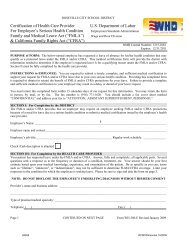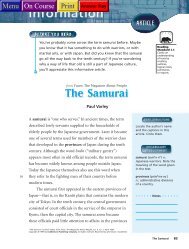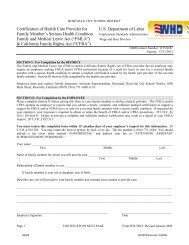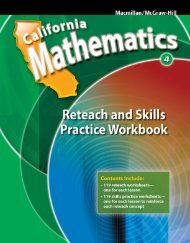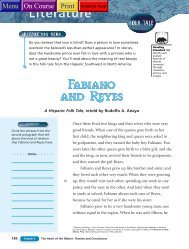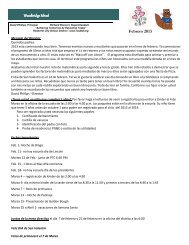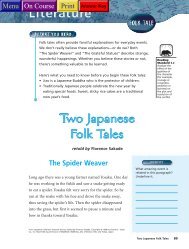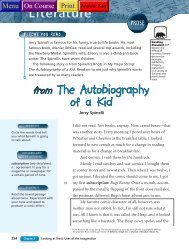Interactive Reading
Interactive Reading
Interactive Reading
You also want an ePaper? Increase the reach of your titles
YUMPU automatically turns print PDFs into web optimized ePapers that Google loves.
Build Independence Through <strong>Interactive</strong> Selections■■■■(<strong>Interactive</strong> <strong>Reading</strong>, pages 156–177)A Wolf and Little Daughterretold by Virginia Hamilton ■ page 157Little Red Riding-Hoodretold by Patricia Pierce ■ page 159Explain to students that they will be reading a folk-tale adaptationas well as the classic version of the story of Little Red Riding-Hood. Have volunteers summarize the version of the story theyknow. Encourage a variety of retellings. Remind the class that newversions of a tale occur when different narrators tell a story.Ask a volunteer to read the Author Study note and the Before YouRead note aloud.Tell students that they will be using the “From Form to Prediction”strategy as they read these paired folk tales.Have students read the first paragraph of “A Wolf and LittleDaughter” and then the first side-column note. Discuss whichwords and phrases in the first paragraph indicate that this could bea Red Riding-Hood story.DIFFERENTIATING INSTRUCTIONA Wolf and Little Daughterand Little Red Riding-Hood■■■Learners Having DifficultyThese students may have troublewith the dialect in “A Wolfand Little Daughter.” Beforethey read this story, have themlisten to both stories readaloud on Audio CD. Allowthem to return to the CD laterif they have trouble with thewritten version.Benchmark Students Bothstories contain language thatmay be difficult. Encouragestudents to paraphrase unfamiliarexpressions or sectionsof text.Advanced Students Invitevolunteers to read these twofolk tales aloud, choosingparts and acting them out asthey read. Seeing the charactersin action and hearing thedialogue will help studentsappreciate this form of fiction’sbasis in oral tradition.■■■■■Have students read the rest of the tale on their own, going on tothe classic version after they’ve finished. Remind students to usethe side-column notes to guide them. As students read, have themcompare and contrast the two versions of the tale. Help them tosee that both tales deal with the same event.Have students respond to the two Fluency notes. Encouragestudents to be expressive when reading aloud.You may wish to photocopy the “From Form to Prediction”Chart in Section Three of the Teacher’s Edition to evaluate students’understanding.Use the Vocabulary Check and the Comprehension Check onTeacher’s Edition pages 52 and 53 to evaluate mastery of thevocabulary and literary standards.Assign the Author Profile project to students as an extensionactivity.TEACHER TO TEACHERTo deal with the dialect in “AWolf and Little Daughter,”explain that dialect is the waypeople speak in certain regionsor areas of the country. Helpstudents to see that dialect helpsreaders to understand the charactersas they are on their home“turf.” Have students skim “AWolf and Little Daughter” tofind examples of dialect todiscuss.Chapter 4 47



